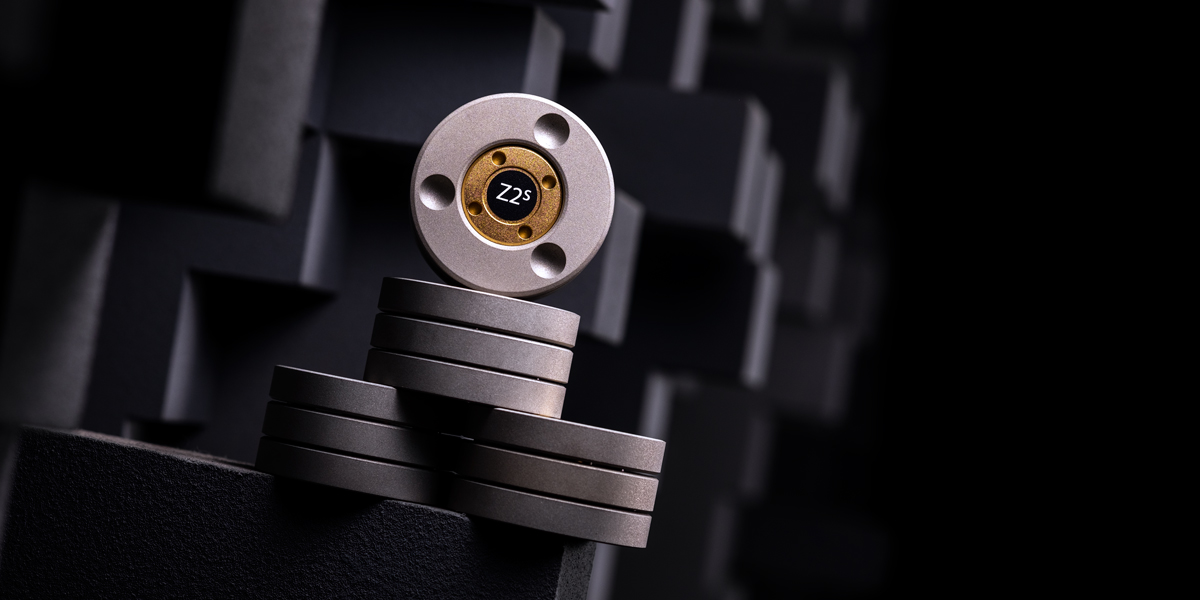Ansuz Darkz T2S decoupler devices proved me in late 2020 how beneficial titanium is for sound quality. Now it’s time to find out whether their recently released zirconium version – Ansuz Darkz Z2S – deserves its place even higher in the offer. Enjoy!
ZrSiO4
Although this site’s most recent Ansuz story dates back to the very last day of 2021, it feels like it’s been ages since then. In that review I’ve explained how I keep away from the insanely expensive tier, but every now and then I tackle such challenges if they’re compact enough for me to handle and manufacturers willing to send them over. Ansuz D-TC Supreme power cord priced at €36’000 was the perfect candidate. Now it’s time to come clean that this extreme Danish type was one of several products shipped to my address on a rather large pallet. Now it’s time to unpeel its next layer, extract yet another box and present its contents here.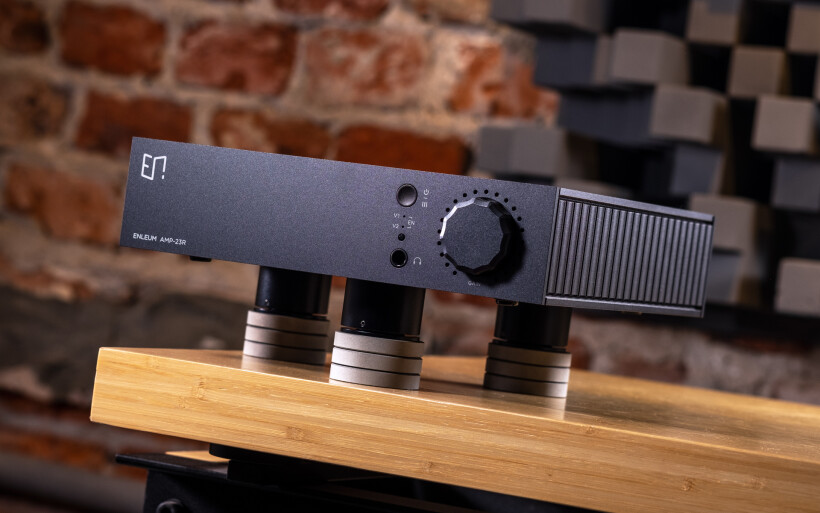 Shortly before that cargo left its homeland yet another Ansuz product had its official premiere. This newcomer device baptized Darkz Z2S that established the new top shelf in its makers’ decoupler roster was tiny to say the least, extremely expensive and available. These were three green lights considering that Ansuz Darkz T2S footers reviewed here already had me thoroughly impressed. I imagined that a specimen above this crazy titanium affair could take a while to launch. Apparently Lady Luck had to be on my side the day that had happened. Just prior to buttoning up logistics my Danish contact Morten included in his hefty package one Darkz Z2S set that was announced a mere week earlier. Lucky me indeed.
Shortly before that cargo left its homeland yet another Ansuz product had its official premiere. This newcomer device baptized Darkz Z2S that established the new top shelf in its makers’ decoupler roster was tiny to say the least, extremely expensive and available. These were three green lights considering that Ansuz Darkz T2S footers reviewed here already had me thoroughly impressed. I imagined that a specimen above this crazy titanium affair could take a while to launch. Apparently Lady Luck had to be on my side the day that had happened. Just prior to buttoning up logistics my Danish contact Morten included in his hefty package one Darkz Z2S set that was announced a mere week earlier. Lucky me indeed.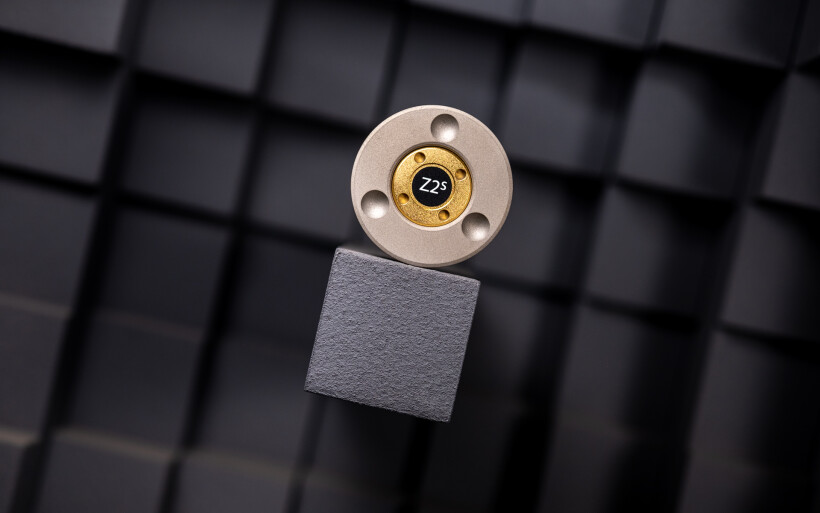 Ansuz’ Darkz lineup includes six performance tiers; C2T, D2T, S2T, T2, T2S and top shelf Z2S. All these hard decoupler devices free from any springy actions and reactions were designed as directional sinks for resonances transferred from a component above into them. Absorbed vibrations turned into heat don’t bounce back up and that’s the common ground for the entire roster, however means to achieve this fundamental goal set each Darkz model apart. A single Darkz Z2S footer measures 44,5 x 23,8mm and comprises of six balls in-between three discs just as its siblings. As such it doesn’t seem too complex at first glance yet is quite intricate up close and perfectly machined. Each plate’s round wells feature three cavities that lock decoupler balls into place. All these ingredients stack into purposely a touch loose three-layered cylinder held in place by two machined inserts bolted together; one on the uppermost piece and the other underneath with a tiny conical recession to accommodate spikes. Each outermost top and bottom piece’s semispherical dimples accept extra balls that allow for stacking additional Darkz one on top of another ad infinitum.
Ansuz’ Darkz lineup includes six performance tiers; C2T, D2T, S2T, T2, T2S and top shelf Z2S. All these hard decoupler devices free from any springy actions and reactions were designed as directional sinks for resonances transferred from a component above into them. Absorbed vibrations turned into heat don’t bounce back up and that’s the common ground for the entire roster, however means to achieve this fundamental goal set each Darkz model apart. A single Darkz Z2S footer measures 44,5 x 23,8mm and comprises of six balls in-between three discs just as its siblings. As such it doesn’t seem too complex at first glance yet is quite intricate up close and perfectly machined. Each plate’s round wells feature three cavities that lock decoupler balls into place. All these ingredients stack into purposely a touch loose three-layered cylinder held in place by two machined inserts bolted together; one on the uppermost piece and the other underneath with a tiny conical recession to accommodate spikes. Each outermost top and bottom piece’s semispherical dimples accept extra balls that allow for stacking additional Darkz one on top of another ad infinitum.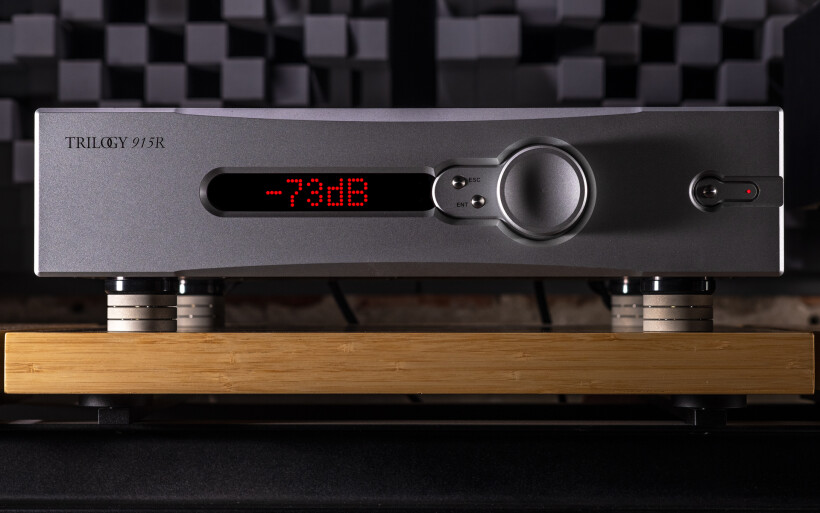 Although all Ansuz Darkz are alike on shape and size, materials and processing measures used to make them aren’t. The entry-level C2T and D2T one notch higher feature anodized aluminium parts for extra hardness, while the latter’s glass-blasted discs also undergo particle bombarding to develop tantalum and diamond coats. Mid-tier ranges S2T and T2 replace aluminium respectively with stainless steel and raw titanium. The latter’s upped T2S version based on the same material of the 2nd grade gets its dosage of particles for 60+ hours to etch layers of tantalum, scandium and diamond deep into its primary surface. This report’s Z2S ditches titanium in favor of zirconium conditioned in a Hi-PIMS (High Power Impulse Magnetron Sputtering) machine to develop tungsten and aluminium titanium nitride skins under one extra zirconium layer for as fine uniform effect as possible. Danes’ processing as described shifts resonant mods of materials involved, so their vibration reduction gets more and more effective and that’s the very reason for all this effort.
Although all Ansuz Darkz are alike on shape and size, materials and processing measures used to make them aren’t. The entry-level C2T and D2T one notch higher feature anodized aluminium parts for extra hardness, while the latter’s glass-blasted discs also undergo particle bombarding to develop tantalum and diamond coats. Mid-tier ranges S2T and T2 replace aluminium respectively with stainless steel and raw titanium. The latter’s upped T2S version based on the same material of the 2nd grade gets its dosage of particles for 60+ hours to etch layers of tantalum, scandium and diamond deep into its primary surface. This report’s Z2S ditches titanium in favor of zirconium conditioned in a Hi-PIMS (High Power Impulse Magnetron Sputtering) machine to develop tungsten and aluminium titanium nitride skins under one extra zirconium layer for as fine uniform effect as possible. Danes’ processing as described shifts resonant mods of materials involved, so their vibration reduction gets more and more effective and that’s the very reason for all this effort.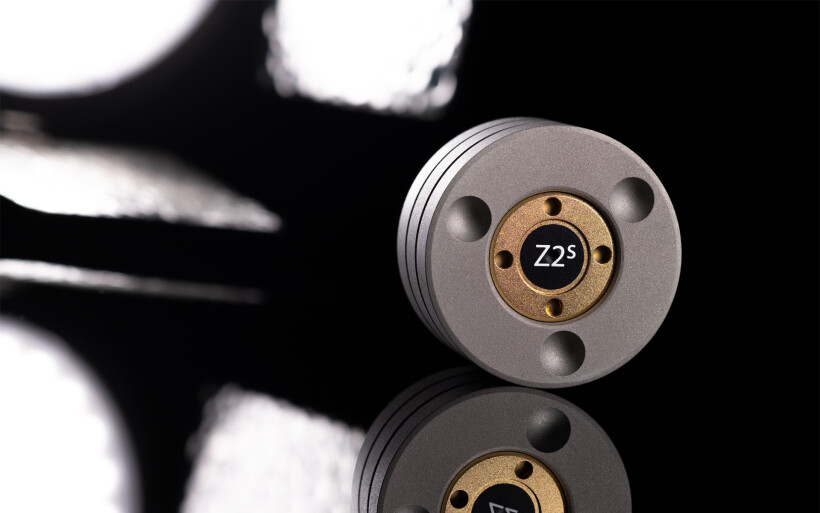 Each Ansuz Darkz C2T/D2T/S2T/T2/T2S puck sells for €270/620/670/780/1’200 respectively, but even the most expensive from this lot is nowhere near this review’s product priced at, hopefully you’re sitting now, €3’500. A single audio component demands at least three such supports and €10’500 on the bill. The letter ‘S’ in Darkz T2S’ name that stands for ‘Supreme’ today screams ‘Signature’. That aside, it seemed only fair to ask Michael about that staggering price. I was told that zirconium doesn’t hold neutrons and is used wherever chromium and nickel won’t do and extremely low-level contamination is a must. Think nuclear and medical applications. Industry-grade zirconium is roughly 10x more expensive than the already costly titanium, very difficult to machine and quite volatile so demands specific environment and tools. It’s also not easily obtainable in large quantities considering primary sectors where it’s used. Upon asking why one would even bother going this route, Danes see zirconium’s efficacy and resonance pattern as special enough to invest and build products around this material. It allows for dissipating unwanted vibrations yet leaving those appealing to our ears in a way not achievable elsewhere, while Darkz Z2S’ interlayer tungsten balls 4x heftier versus their titanium counterparts further support this plan.
Each Ansuz Darkz C2T/D2T/S2T/T2/T2S puck sells for €270/620/670/780/1’200 respectively, but even the most expensive from this lot is nowhere near this review’s product priced at, hopefully you’re sitting now, €3’500. A single audio component demands at least three such supports and €10’500 on the bill. The letter ‘S’ in Darkz T2S’ name that stands for ‘Supreme’ today screams ‘Signature’. That aside, it seemed only fair to ask Michael about that staggering price. I was told that zirconium doesn’t hold neutrons and is used wherever chromium and nickel won’t do and extremely low-level contamination is a must. Think nuclear and medical applications. Industry-grade zirconium is roughly 10x more expensive than the already costly titanium, very difficult to machine and quite volatile so demands specific environment and tools. It’s also not easily obtainable in large quantities considering primary sectors where it’s used. Upon asking why one would even bother going this route, Danes see zirconium’s efficacy and resonance pattern as special enough to invest and build products around this material. It allows for dissipating unwanted vibrations yet leaving those appealing to our ears in a way not achievable elsewhere, while Darkz Z2S’ interlayer tungsten balls 4x heftier versus their titanium counterparts further support this plan.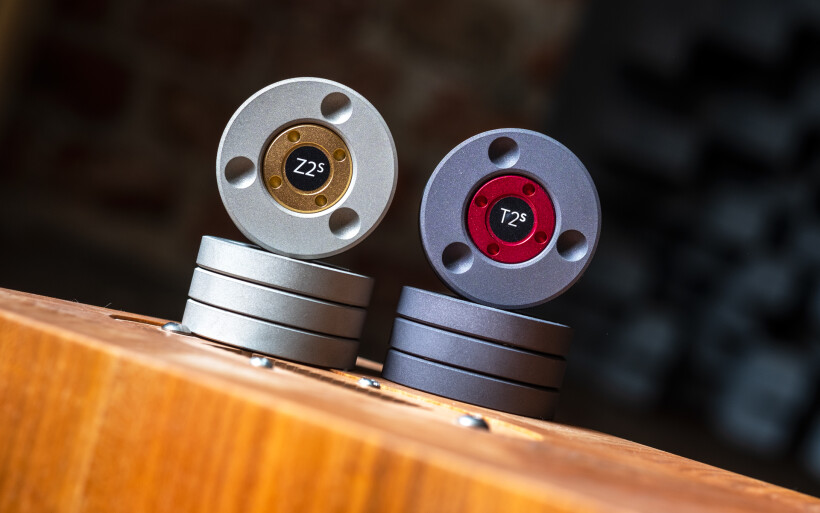 I usually use three footers per component to make their swaps and leveling easier. Six Ansuz Darkz T2S sent my way in late 2020 were enough to work under two products, but not their four Z2S siblings as reviewed today. That’s why sound|kaos Vox 3afw monitors in demand of at least two more had to be off duty. Not only this, the Bakoon AMP-13R and fidata HFAS1-S10U used in the former review were respectively dethroned by the Enleum AMP-23R and Innuos Statement on their own decoupler legs. Still, the choice of devices that should go on top of Darkz Z2S cylinders was obvious. My DAC and preamp as the most susceptible to any tweaks were easy picks, however triangulations to map where Ansuz’ latest anti-resonance buggers contributed the most wasn’t the primary goal. If I were after these painfully costly pucks as a paying customer, I’d really like to know whether stepping up from their makers’ already silly good T2S range would result in sonic gains obvious enough to justify the extra expense. That’s why my order included a set of each Darkz Z2S and T2S. Morten happily obliged. Here it’s also worth noting that to perform at their highest gear all Darkz were used directly below my components’ undersides, not their original footers. I’ve stacked them all just to make photos this much more readable and that’s it.
I usually use three footers per component to make their swaps and leveling easier. Six Ansuz Darkz T2S sent my way in late 2020 were enough to work under two products, but not their four Z2S siblings as reviewed today. That’s why sound|kaos Vox 3afw monitors in demand of at least two more had to be off duty. Not only this, the Bakoon AMP-13R and fidata HFAS1-S10U used in the former review were respectively dethroned by the Enleum AMP-23R and Innuos Statement on their own decoupler legs. Still, the choice of devices that should go on top of Darkz Z2S cylinders was obvious. My DAC and preamp as the most susceptible to any tweaks were easy picks, however triangulations to map where Ansuz’ latest anti-resonance buggers contributed the most wasn’t the primary goal. If I were after these painfully costly pucks as a paying customer, I’d really like to know whether stepping up from their makers’ already silly good T2S range would result in sonic gains obvious enough to justify the extra expense. That’s why my order included a set of each Darkz Z2S and T2S. Morten happily obliged. Here it’s also worth noting that to perform at their highest gear all Darkz were used directly below my components’ undersides, not their original footers. I’ve stacked them all just to make photos this much more readable and that’s it. Let me first recap how much of an impact Ansuz Darkz T2S had on my setup. A set of three these footers landed just under the Bakoon’s two most protruding heat dissipation nodes plus its round block with a transformer inside. This integrated amp was by far the easiest to lift and move around of all key components I had at my disposal back then. Although on top of three LessLoss Bindbreakers it didn’t sound all that different at first, a single swap to Darkz T2S revealed changes as noticeable as they were instant. So much so in fact that tracking these performance shifts didn’t require any focus on my end and that already was telling. The Bakoon supported by Danish footers produced various synth bass lines clearly beefier, quicker, tighter, extended better, more cohesive, composed and tactile, while vocal jobs were stripped from edginess, excessive heat and grain. Titanium discs made calm polite male voices even more comforting, substantial, smoother and outlined finer. All key sound sources were more distinctively isolated, fleshier, less pale and free from nervousness. Danish pucks also acted as potent horsepower boosters that effectively expanded dynamic contrasts and secured extra punch and snap. All the sensible increase on heft, bite and articulation served all at once without any downsides marked Ansuz T2S an obvious highly efficient upgrade.
Let me first recap how much of an impact Ansuz Darkz T2S had on my setup. A set of three these footers landed just under the Bakoon’s two most protruding heat dissipation nodes plus its round block with a transformer inside. This integrated amp was by far the easiest to lift and move around of all key components I had at my disposal back then. Although on top of three LessLoss Bindbreakers it didn’t sound all that different at first, a single swap to Darkz T2S revealed changes as noticeable as they were instant. So much so in fact that tracking these performance shifts didn’t require any focus on my end and that already was telling. The Bakoon supported by Danish footers produced various synth bass lines clearly beefier, quicker, tighter, extended better, more cohesive, composed and tactile, while vocal jobs were stripped from edginess, excessive heat and grain. Titanium discs made calm polite male voices even more comforting, substantial, smoother and outlined finer. All key sound sources were more distinctively isolated, fleshier, less pale and free from nervousness. Danish pucks also acted as potent horsepower boosters that effectively expanded dynamic contrasts and secured extra punch and snap. All the sensible increase on heft, bite and articulation served all at once without any downsides marked Ansuz T2S an obvious highly efficient upgrade.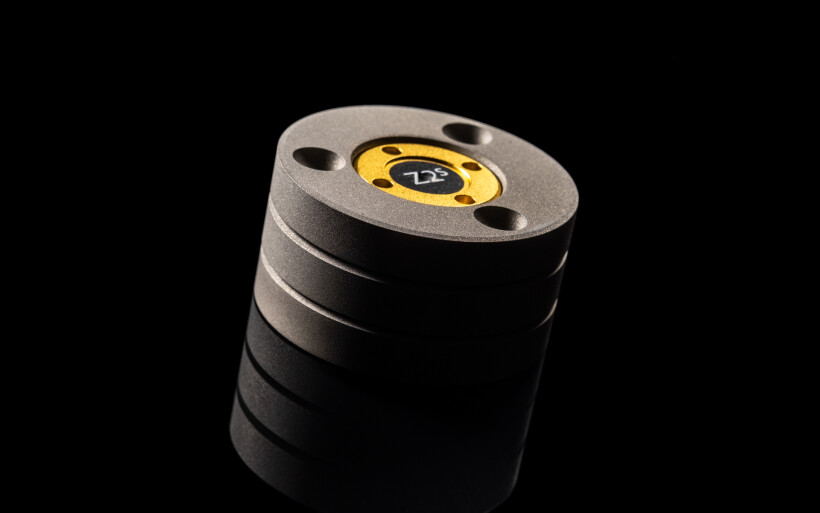 The Bakoon on top of three titanium supports projected all virtual shapes internally more moist and darker, which was the well-known highly appreciated effect of their foundational silencing action. Here the guideline is simple; the more efficaciously a component trims noise, the fuller and more pronounced each instrumental and vocal line becomes, while the backdrop behind them gets sensibly blacker and blacker in the process. That said, Bakoon’s integrated amp with Ansuz’ legs underneath did brilliantly on on-stage presence of voices. Their explicit internally meaty frames were as admirably distinct as all subtle whispers and body fluids registered by microphones. Such delicate content extracted this noticeably upped the ante on articulation and resolution, but to my ears the key focal point was elsewhere. Darkz T2S added extra gravity, organic vibe, vividness and speed, while upon disengaging them the entire landscape felt more flat, texturally simpler, less clear on vocal intricacies, slower and less majestic all in all. This audible change was nothing new per se. I’ve had my fair share of potent USB sorters, power bars and cords designed to reduce incoming noise and act accordingly. Still, tiny passive decoupler discs capable of pulling alike stunts as effectively was the surprise that caught me off guard.
The Bakoon on top of three titanium supports projected all virtual shapes internally more moist and darker, which was the well-known highly appreciated effect of their foundational silencing action. Here the guideline is simple; the more efficaciously a component trims noise, the fuller and more pronounced each instrumental and vocal line becomes, while the backdrop behind them gets sensibly blacker and blacker in the process. That said, Bakoon’s integrated amp with Ansuz’ legs underneath did brilliantly on on-stage presence of voices. Their explicit internally meaty frames were as admirably distinct as all subtle whispers and body fluids registered by microphones. Such delicate content extracted this noticeably upped the ante on articulation and resolution, but to my ears the key focal point was elsewhere. Darkz T2S added extra gravity, organic vibe, vividness and speed, while upon disengaging them the entire landscape felt more flat, texturally simpler, less clear on vocal intricacies, slower and less majestic all in all. This audible change was nothing new per se. I’ve had my fair share of potent USB sorters, power bars and cords designed to reduce incoming noise and act accordingly. Still, tiny passive decoupler discs capable of pulling alike stunts as effectively was the surprise that caught me off guard.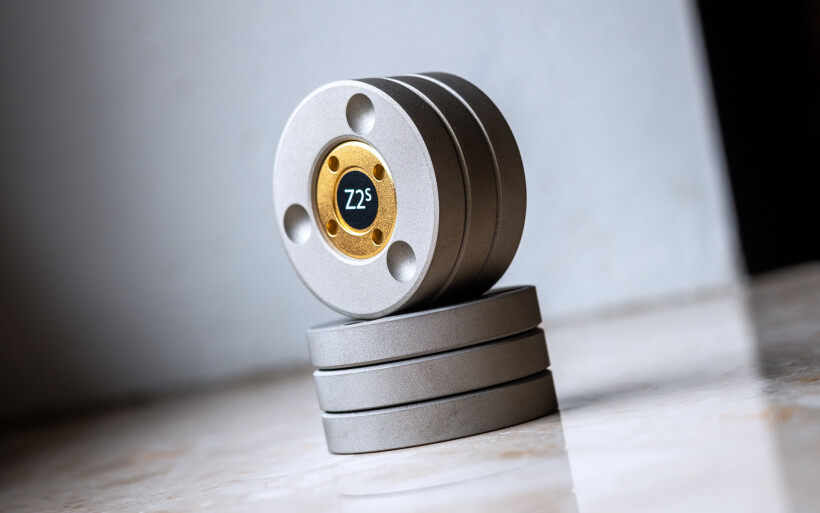 Ansuz Darkz T2S installed under fidata HFAS1-S10U server/streamer resulted in familiar yet sensibly stronger gains and in that sense not surprising by any means. Digital components make a signal for downstream devices not to fix but further process it, so the sooner it gets cleaned up the better. Put shortly, fidata’s platform located before the Bakoon benefited from titanium footers more, but partially also because the latter got a pre-conditioned signal that was nicer to work on. At this point T2S’ action just under my DAC’s own massive Stacore legs without their critical bases was predictable; heftier snappier more articulate bass, ambience with lesser grain in it, wider color palette, greater clarity and more lively sportier smoother voicing overall. These were massive easily audible changes. Although Stacore’s fully assembled cylinders were almost on par with Ansuz’ pucks on sheer speed and spatial cleanliness, the latter set had the clear upper hand on finer textures, higher contrast ratio plus bass that dug deeper, felt tighter and effectively hit harder.
Ansuz Darkz T2S installed under fidata HFAS1-S10U server/streamer resulted in familiar yet sensibly stronger gains and in that sense not surprising by any means. Digital components make a signal for downstream devices not to fix but further process it, so the sooner it gets cleaned up the better. Put shortly, fidata’s platform located before the Bakoon benefited from titanium footers more, but partially also because the latter got a pre-conditioned signal that was nicer to work on. At this point T2S’ action just under my DAC’s own massive Stacore legs without their critical bases was predictable; heftier snappier more articulate bass, ambience with lesser grain in it, wider color palette, greater clarity and more lively sportier smoother voicing overall. These were massive easily audible changes. Although Stacore’s fully assembled cylinders were almost on par with Ansuz’ pucks on sheer speed and spatial cleanliness, the latter set had the clear upper hand on finer textures, higher contrast ratio plus bass that dug deeper, felt tighter and effectively hit harder.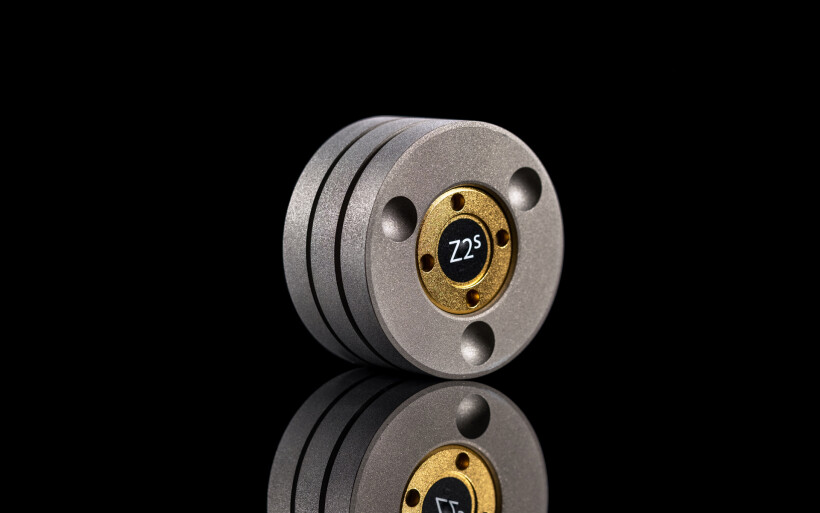 Prior to the Innuos Statement’s arrival my DAC used to sit on fidata’s bonnet very fond of extra mass. That’s why three out of six Darkz T2S I had back then landed under that transport and Pacific just above it on as many. The resulting sandwich introduced yet another audible performance spike that was more pronounced versus the same stack formed during the LessLoss Bindbreaker test. This experience translated into Darkz T2S’ higher overall impact, while my digital hardware’s ability to scale up with them was generous to say the least. Simply put, six titanium pucks did more than three. I had all the data to finish my story, but the idea of trying out these footers under sound|kaos Vox 3afw seemed appealing and I was glad that I did that. Swiss monitors supported by T2S produced bass that yet again struck me as deeper, more extended and tighter. Its increased quantity secured additional points on bloom and prettiness, while all the control that followed packed extra punch and banished any residual wobble in my room. The severity of these reworks was the main takeaway, not their character. Although Martin Gateley’s petite speakers are off-charts performers on their own right, without Danish titanium their downstairs department was noticeably less capable. On some tracks with the Bakoon these monitors also routinely showed vocal attitude on the verge of being a touch too outlined, shiny and lean. With T2S engaged this was no more however, the effect was noticeably smoother and more substantial.
Prior to the Innuos Statement’s arrival my DAC used to sit on fidata’s bonnet very fond of extra mass. That’s why three out of six Darkz T2S I had back then landed under that transport and Pacific just above it on as many. The resulting sandwich introduced yet another audible performance spike that was more pronounced versus the same stack formed during the LessLoss Bindbreaker test. This experience translated into Darkz T2S’ higher overall impact, while my digital hardware’s ability to scale up with them was generous to say the least. Simply put, six titanium pucks did more than three. I had all the data to finish my story, but the idea of trying out these footers under sound|kaos Vox 3afw seemed appealing and I was glad that I did that. Swiss monitors supported by T2S produced bass that yet again struck me as deeper, more extended and tighter. Its increased quantity secured additional points on bloom and prettiness, while all the control that followed packed extra punch and banished any residual wobble in my room. The severity of these reworks was the main takeaway, not their character. Although Martin Gateley’s petite speakers are off-charts performers on their own right, without Danish titanium their downstairs department was noticeably less capable. On some tracks with the Bakoon these monitors also routinely showed vocal attitude on the verge of being a touch too outlined, shiny and lean. With T2S engaged this was no more however, the effect was noticeably smoother and more substantial.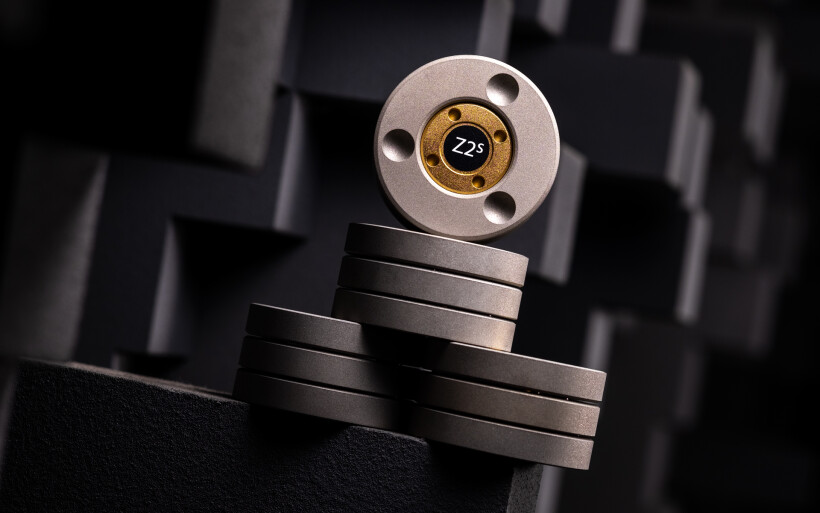 Since Ansuz Darkz T2S did an awful lot regardless of application and I wasn’t aware of anything better then, that review should’ve ended with an award. It didn’t simply because I’ve sampled similar accessories yet none this costly, so I had no idea where the ceiling was and wasn’t ready to go red on decoupler devices. I also wondered whether their kind could possibly get any more potent. Now I know and it’s quite silly how much more these accessories can still do. Although the Darkz T2S experience was plenty intense already, Danes’ rosters offer the biggest performance leaps upon going from their second best to top tier. Ansuz Darkz Z2S makes that point very well by being a substantially better product in comparison to its predecessor.
Since Ansuz Darkz T2S did an awful lot regardless of application and I wasn’t aware of anything better then, that review should’ve ended with an award. It didn’t simply because I’ve sampled similar accessories yet none this costly, so I had no idea where the ceiling was and wasn’t ready to go red on decoupler devices. I also wondered whether their kind could possibly get any more potent. Now I know and it’s quite silly how much more these accessories can still do. Although the Darkz T2S experience was plenty intense already, Danes’ rosters offer the biggest performance leaps upon going from their second best to top tier. Ansuz Darkz Z2S makes that point very well by being a substantially better product in comparison to its predecessor. For the sake of having things simple let me stress that Darkz T2S’ key fortes were its quickness, openness, background blackness, clarity and spatial cleanliness, so features that injected generous hi-res flavor into any component on top of these footers. In this context a set of Darkz Z2S under my hardware of choice did the same yet more audibly to then escalate from there by significantly boosting saturation, heft, spatial presence and sensation of on-stage might. That behavior resulted in aural intensity beyond the Darkz T2S’ reach, but the greatest surprise of them all was in how much different today’s loaner set was at its core and how much more potent. Even if prior to its delivery subconsciously I was ready for most aspects a touch better here and there, after several back and forths between both Darkz types my ears registered primarily heavyweight sonic reworks that I hadn’t seen coming. To be fair, I don’t think that anyone already familiar with Ansuz’ accessories would. Manufacturers often stick to their house sound that remains uniform regardless of price. On that front Darkz Z2S is no less than a proper Ansuz job that clearly shows traits cherished by its makers. But then again, this is also an effort highly evolved in a brand new direction that zirconium apparently had to unlock just now.
For the sake of having things simple let me stress that Darkz T2S’ key fortes were its quickness, openness, background blackness, clarity and spatial cleanliness, so features that injected generous hi-res flavor into any component on top of these footers. In this context a set of Darkz Z2S under my hardware of choice did the same yet more audibly to then escalate from there by significantly boosting saturation, heft, spatial presence and sensation of on-stage might. That behavior resulted in aural intensity beyond the Darkz T2S’ reach, but the greatest surprise of them all was in how much different today’s loaner set was at its core and how much more potent. Even if prior to its delivery subconsciously I was ready for most aspects a touch better here and there, after several back and forths between both Darkz types my ears registered primarily heavyweight sonic reworks that I hadn’t seen coming. To be fair, I don’t think that anyone already familiar with Ansuz’ accessories would. Manufacturers often stick to their house sound that remains uniform regardless of price. On that front Darkz Z2S is no less than a proper Ansuz job that clearly shows traits cherished by its makers. But then again, this is also an effort highly evolved in a brand new direction that zirconium apparently had to unlock just now.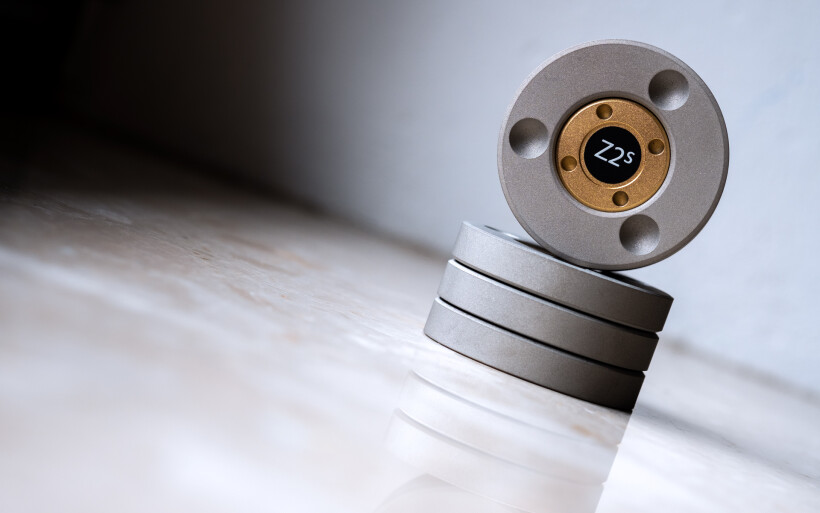 To keep any expectation biases at bay I like to first listen and eventually ask questions afterwards. Once I had a firm notion how Darkz Z2S fared against their titanium siblings, or rather how much different and higher-tiered they were, it was time to make some extra calls. My contact Morten suggested talking directly to the company’s CTO Michael Børresen who happily explained a thing or two about his latest material of choice, but also casually mentioned that zirconium and titanium don’t sound alike. With first comparative auditions under my belt I knew this already, but more importantly we were on the same exact boat and I don’t find that a coincidence in the slightest. The difference between the two Darkz sets sent my way was simply too obvious and quite frankly staggering to have any doubts about which one did more, felt heftier, provided even blacker background and marked the clear progress.
To keep any expectation biases at bay I like to first listen and eventually ask questions afterwards. Once I had a firm notion how Darkz Z2S fared against their titanium siblings, or rather how much different and higher-tiered they were, it was time to make some extra calls. My contact Morten suggested talking directly to the company’s CTO Michael Børresen who happily explained a thing or two about his latest material of choice, but also casually mentioned that zirconium and titanium don’t sound alike. With first comparative auditions under my belt I knew this already, but more importantly we were on the same exact boat and I don’t find that a coincidence in the slightest. The difference between the two Darkz sets sent my way was simply too obvious and quite frankly staggering to have any doubts about which one did more, felt heftier, provided even blacker background and marked the clear progress.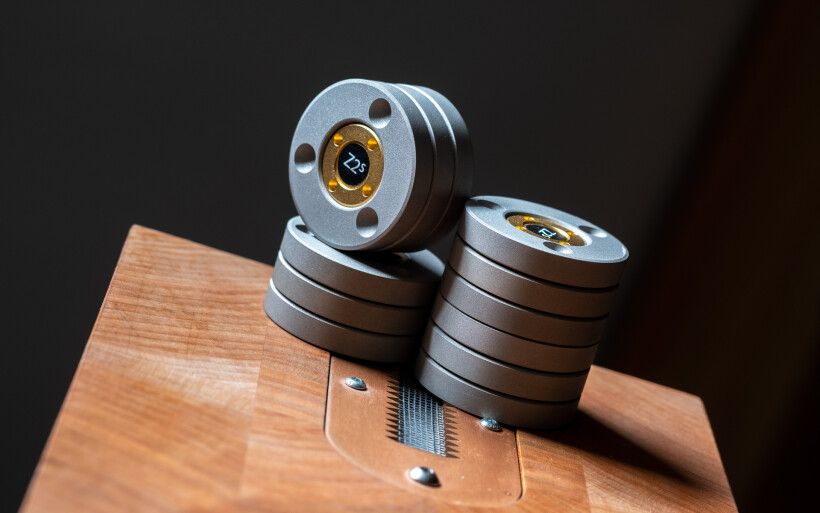 Although the above might imply two profiles tailored for differently voiced setups, that wasn’t the case at all. On tracks that unmasked Darkz T2S as primarily lean and agile its successor felt heftier but not any slower, dimmed or chunkier. All occasions for the former to dig really deep, be tight and powerful the latter used to go even deeper and present itself as the more muscular of the two that slammed harder on top of that. If titanium cylinders knew well how to pump air, present radiance and extend decays, zirconium pucks gladly followed accordingly to up the ante on even longer weightier shimmers and making the entire brilliance region finer. Darkz T2S’ spatial projections were pinpoint accurate, superbly separated and vivid, while Darkz Z2S made these frames a touch thicker yet internally far more moist and fleshier to net higher notes on in-room presence and tactile feel. The former set did everything a product this costly really should, but its newcomer kin made music noticeably more alive and touchable. Long story short, I couldn’t single out one count where titanium would beat zirconium or even emerge on par with it. On a privy note I dig titanium looks more, but that is entirely irrelevant.
Although the above might imply two profiles tailored for differently voiced setups, that wasn’t the case at all. On tracks that unmasked Darkz T2S as primarily lean and agile its successor felt heftier but not any slower, dimmed or chunkier. All occasions for the former to dig really deep, be tight and powerful the latter used to go even deeper and present itself as the more muscular of the two that slammed harder on top of that. If titanium cylinders knew well how to pump air, present radiance and extend decays, zirconium pucks gladly followed accordingly to up the ante on even longer weightier shimmers and making the entire brilliance region finer. Darkz T2S’ spatial projections were pinpoint accurate, superbly separated and vivid, while Darkz Z2S made these frames a touch thicker yet internally far more moist and fleshier to net higher notes on in-room presence and tactile feel. The former set did everything a product this costly really should, but its newcomer kin made music noticeably more alive and touchable. Long story short, I couldn’t single out one count where titanium would beat zirconium or even emerge on par with it. On a privy note I dig titanium looks more, but that is entirely irrelevant.
Witnessing how much the two Darkz subjects differed was a major treat, but Ansuz Darkz Z2S’ far higher overall efficacy was obvious to a degree I truly hadn’t expected. This extremely costly proposition is for those lucky few who live in mansions, see such expenses as casual pleasures and spare no coin to get the very best. It surpassed its titanium sibling by a significant margin where it mattered the most, evenly combined mutually exclusive traits built around thick and quick cores and went off-charts on overall impact it had on my hardware. Along with wrapping my head around these advantages came the firm idea how to finish this story. I can’t name any other decoupler sorter that on performance would come any close to Danes’ latest zirconium effort, not even their own titanium range. It represents just the ceiling that deserves the award below.
Associated Equipment:
- Amplifier: Trilogy 995R, FirstWatt F7, Enleum AMP-23R
- DAC: LampizatOr Pacific (KR Audio T-100 / Living Voice 300B + KR Audio 5U4G Ltd. Ed.)
- Speakers: Boenicke Audio W11 SE+, sound|kaos Vox 3afw
- Transport: Innuos Statement
- Preamplifier: Trilogy 915R, Thöress DFP
- Speaker cables: Boenicke Audio S3, LessLoss C-MARC
- Headphones: HifiMan Susvara
- Speaker signal conditioning: LessLoss Firewall for Loudspeakers
- Anti-vibration conditioning: 12x Carbide Audio Carbide Bases (under DAC, preamp and speakers)
- Interconnects: LessLoss Entropic Process C-MARC, Boenicke Audio IC3 CG
- Power components: Gigawatt PC-3 SE EVO+/LC-3 EVO, LessLoss C-MARC, LessLoss Entropic Process C-MARC, Boenicke Audio Power Gate, ISOL-8 Prometheus
- USB components: iFi audio Mercury3.0
- Rack: Franc Audio Accesories Wood Block Rack
- Network: Fidelizer EtherStream, Linksys WRT160N
- Music: NativeDSD
Retail prices of reviewed components in EU (incl. tax):
- Ansuz Darkz Z2S: €3’500/ea.
Manufacturer: Ansuz Acoustics


